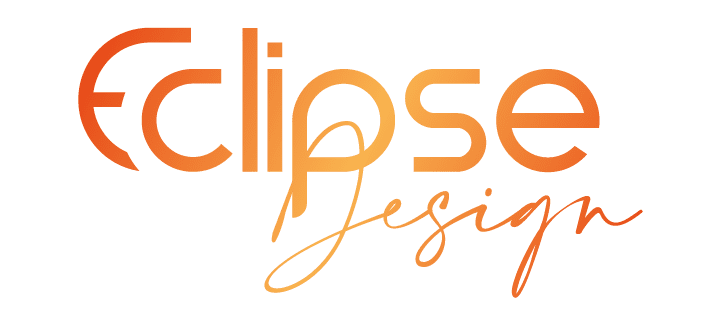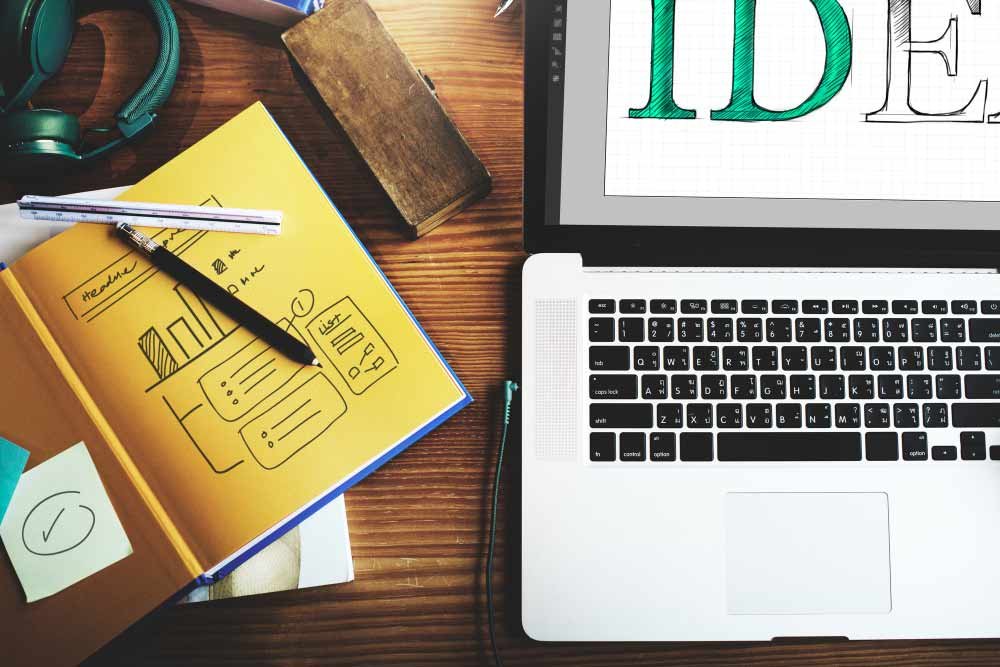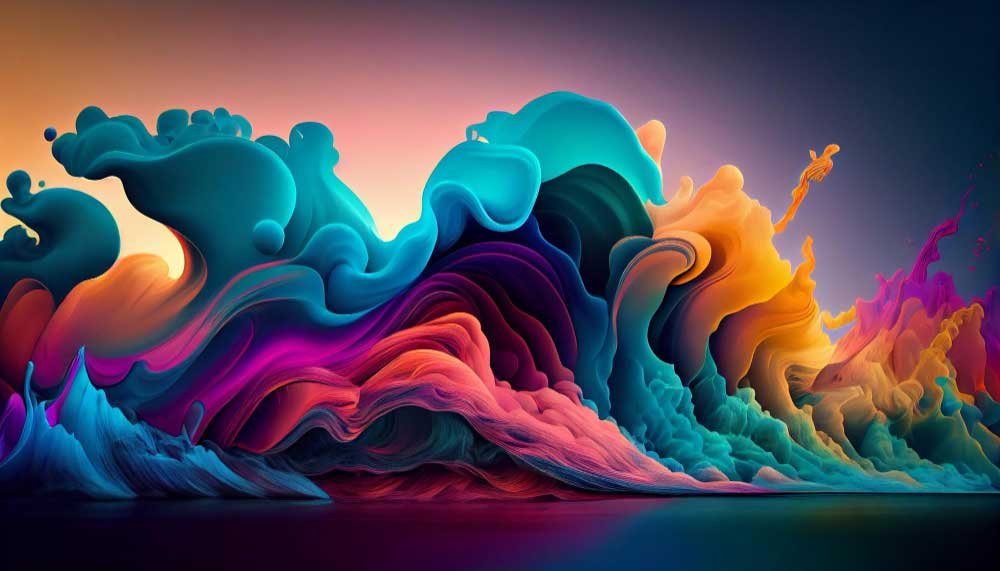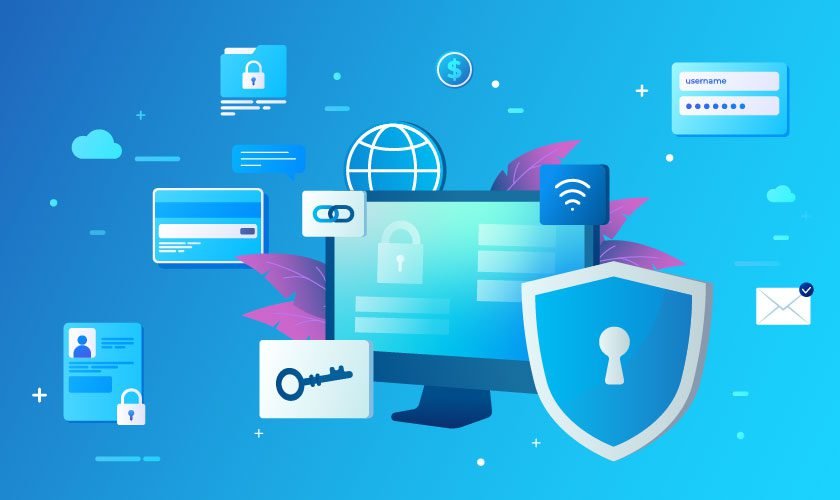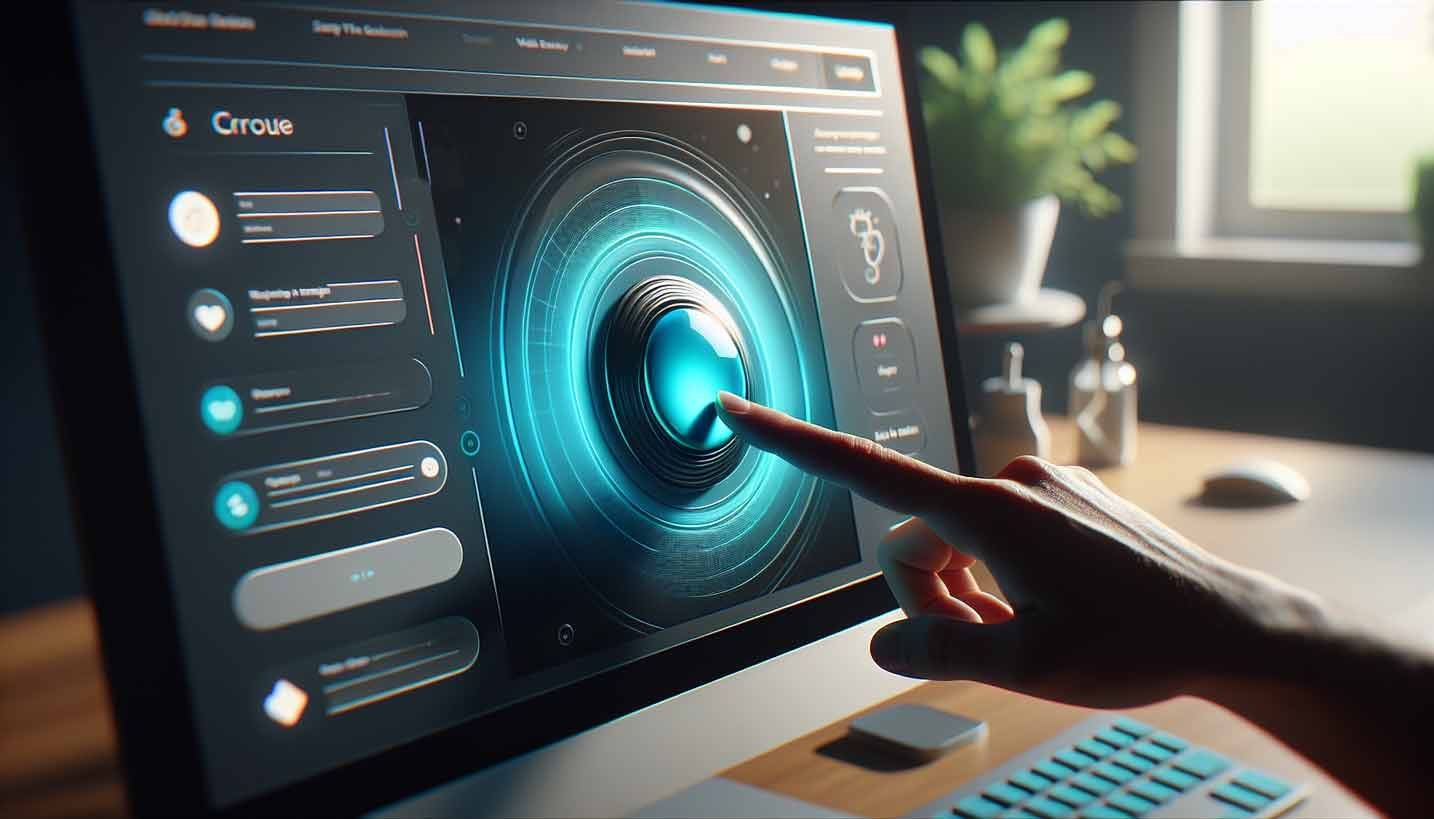- Related Categories: Branding, Graphic Design, Graphic Design Tips, How To
Table of Contents

As a graphic designer, I have witnessed firsthand the power of graphic design in shaping a brand’s identity and driving its success. In today’s digital age, where consumers are bombarded with information and choices, having a strong and memorable brand is more important than ever. In this article, I will explore the several ways in which graphic design can enhance brand identity, the power of visual storytelling, the role of logo design, typography, web design, finding design inspiration, building a standout design portfolio, keeping up with design trends, and essential design tools for graphic designers.
The Importance of Graphic Design in Branding
In today’s competitive business landscape, where consumers are bombarded with countless options, establishing a strong brand identity is crucial for success. Graphic design is a visual communication tool that helps businesses convey their message, values, and personality to their target audience. It is the art of combining images, typography, colors, and layout to create visually compelling materials that leave a lasting impression.
The power of graphic design in branding cannot be overstated. A thoughtfully crafted logo, a beautifully designed website, or an eye-catching brochure can instantly captivate the audience and create a perception of the brand. Moreover, a well-designed brand identity not only captures attention but also builds trust and credibility. Consistency in design across various touchpoints and medias, such as websites, social media, packaging, and advertisements, helps create a cohesive brand experience. It is through graphic design that businesses can differentiate themselves from their competitors, establish a strong presence in the market, and build trust with their customers.
How Graphic Design Enhances Brand Identity
Brand identity is the face of a business, and graphic design plays a key role in shaping and enhancing it. By carefully selecting colors that align with the brand’s personality and values, graphic designers can evoke specific emotions and create a strong visual association with the brand. Additionally, the use of shapes and images can further reinforce the brand’s message and leave an impression on the audience.
Typography is another important aspect of graphic design that contributes to brand identity. The choice of fonts can convey a sense of professionalism, playfulness, elegance, or any other desired characteristic. Consistency in typography across different marketing materials ensures a cohesive and recognizable brand identity.
The Power of Visual Storytelling in Graphic Design
Visual storytelling is a powerful tool that graphic designers can utilize to create a deep emotional connection with the audience. By combining compelling visuals with a well-crafted narrative, designers can convey complex ideas, evoke emotions, and leave a lasting impact on the viewers.
Through visual storytelling, brands can communicate their values, mission, and unique selling propositions in a way that resonates with their target audience. Whether through illustrations, infographics, or interactive elements, graphic design can transform information into engaging and memorable stories that captivate the audience and strengthen brand loyalty.
Creating a Memorable Brand with Logo Design

A logo is the visual representation of a brand and serves as its most recognizable symbol. A well-designed logo can instantly communicate a brand’s identity and evoke emotions and associations with the audience. It acts as a visual anchor and helps consumers identify and remember a brand among its competitors.
When designing a logo, graphic designers carefully consider the brand’s personality, target audience, and industry. They choose colors, shapes, and typography that align with the brand’s values and create a unique and memorable visual identity. But how can a graphic designer utilize and use that knowledge to create this memorable logo? First, graphic designers need to understand the meaning of a logo.
Understanding the Significance of a Logo
At its core, a logo is the face of a brand, serving as a visual representation that consumers can easily recognize and associate with. It acts as a beacon, guiding consumers towards the brand and reinforcing its identity across various platforms. However, the impact of a logo extends far beyond its immediate visual appeal. It is a compact representation of a brand’s promise, a visual handshake that fosters familiarity and trust.
In order to create a memorable brand, graphic designers need to understand that a logo is more than a graphic; it is a language of symbols that communicates the essence of a brand to consumers, often in the blink of an eye. This symbol becomes a trusted companion for consumers, forging a connection that goes beyond the transactional. As consumers navigate the vast marketplace, a well-crafted logo acts as a beacon, guiding them toward the brand that aligns with their preferences and values. The significance of a logo lies not only in its aesthetic appeal but in its ability to act as a powerful storyteller, narrating the brand’s journey and inviting consumers to be part of the narrative.
The Elements of Effective Logo Design
Crafting a compelling logo requires careful consideration of various elements, each contributing to its overall impact and memorability:
- Understanding the Brand Identity: Before putting pen to paper (or cursor to screen), designers delve deep into the brand’s identity, dissecting its values, mission, and unique selling propositions. By understanding what sets the brand apart from its competitors and resonates with its audience, designers lay the foundation for a logo that encapsulates the brand’s essence.
- Visual Elements: From colors and shapes to typography and imagery, every visual element of a logo plays a crucial role in conveying the brand’s message and eliciting an emotional response from the audience. Designers meticulously select colors that evoke the desired emotions and align with the brand’s personality, ensuring consistency across all brand collateral.
- Typography: The choice of typography can influence the perception of a logo, conveying nuances of professionalism, creativity, or sophistication. Whether opting for a timeless serif font or a modern sans-serif typeface, designers carefully consider how typography reinforces the brand’s identity and enhances its visual appeal.
- Versatility and Scalability: A logo must be versatile enough to adapt to various applications and scales without sacrificing its legibility or impact. Designers ensure that the logo remains recognizable whether displayed on a billboard or resized for a social media profile picture, maintaining its visual integrity across all platforms.
- Timelessness and Longevity: While trends come and go, a well-designed logo stands the test of time, transcending fleeting fads and retaining its relevance for years to come. Designers strike a delicate balance between contemporary aesthetics and timeless appeal, ensuring that the logo remains relevant and resonant amid evolving consumer tastes.
- Differentiation and Distinction: In a crowded marketplace, a distinctive logo is essential for standing out from competitors and capturing the audience’s attention. Designers explore innovative approaches to logo design, seeking to create a visual identity that is as unique as the brand it represents.
The Role of Typography in Graphic Design
Typography, as we previously explored, holds a pivotal role in graphic design, serving as a powerful tool to shape a brand’s image and influence how it is perceived. The selection and arrangement of fonts wield the ability to evoke a spectrum of emotions and traits, ranging from professionalism and playfulness to elegance and reliability.
But how graphic designer chooses the right fonts for your logo or what about the art of mixing different fonts?
Choosing Fonts for Specific Logo Goals
Different logo goals require different typographic choices to effectively convey the desired message. Here is a brief guide to selecting fonts for common logo goals:
- Professionalism: For brands aiming to convey professionalism and trustworthiness, opt for clean, classic fonts with a timeless appeal. Serif fonts like Times New Roman or Garamond exude a sense of tradition and reliability, while sans-serif fonts like Helvetica or Futura offer a modern, minimalist aesthetic.
- Playfulness: Brands targeting a younger or more playful audience can experiment with quirky, whimsical fonts that reflect a sense of fun and creativity. Handwritten fonts or playful script fonts inject personality into the logo and resonate with audiences seeking a lighthearted experience.
- Elegance: For luxury brands or those seeking to evoke a sense of sophistication and elegance, elegant serif fonts with intricate details and graceful curves are an excellent choice. Fonts like Bodoni or Didot exude refinement and luxury, making them ideal for high-end brands.
- Reliability: Brands emphasizing reliability and stability should opt for sturdy, dependable fonts with a strong presence. Bold, sans-serif fonts like Arial or Franklin Gothic convey strength and solidity, instilling confidence in the brand’s offerings.
Mixing Fonts for Logo Design
When it comes to creating a logo, the choice of fonts can make a profound impact on how your brand is perceived. Mixing different fonts can add depth and personality to your logo, but it requires a delicate balance to ensure harmony and readability. Here are some tips for effectively mixing fonts in logo design:
- Contrast: Pairing fonts with contrasting styles can create visual interest and highlight different aspects of your brand. For example, pairing a bold, sans-serif font with a delicate script font can convey a sense of modernity and sophistication.
- Consistency: While mixing fonts, it is important to maintain consistency in certain aspects such as weight, style, or proportion. Consistent elements help tie the different fonts together cohesively, ensuring that your logo looks polished and unified.
- Hierarchy: Establishing a clear hierarchy among the fonts in your logo can help guide the viewer’s eye and communicate the most important aspects of your brand. Reserve elaborates or decorative fonts for the brand name or key elements, while using simpler, more legible fonts for supporting text or taglines.
- Limitation: Avoid overloading your logo with too many different fonts, as it can lead to clutter and confusion. Instead, aim for a balanced combination of fonts that enhance the overall design without overwhelming the viewer.
Font Combination Examples for Logo Design
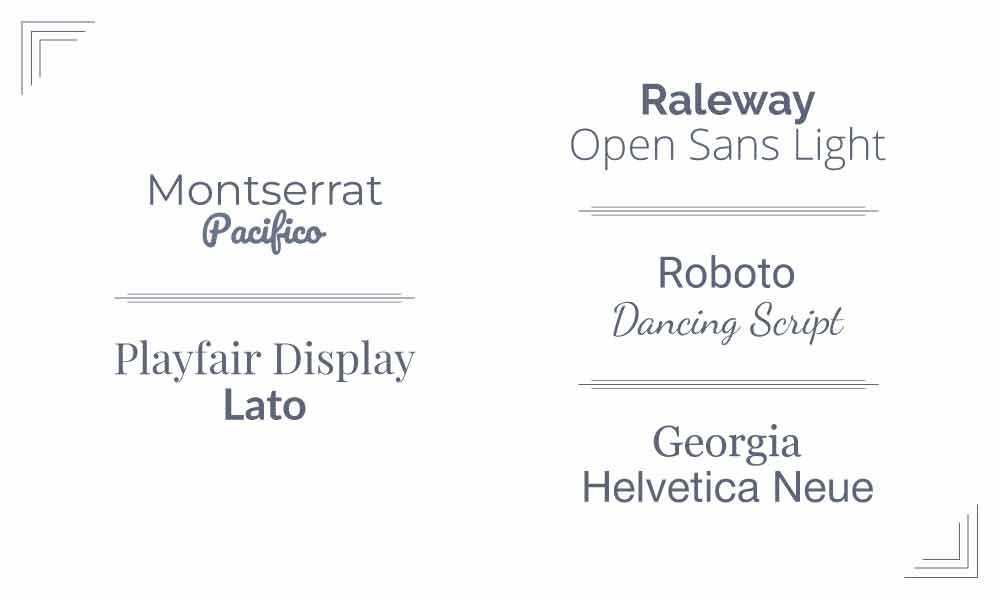
Now that we have discussed the principles of mixing fonts, let us explore some practical examples of font combinations for logo design:
- Modern & Script:
- Modern Font: Montserrat
- Script Font: Pacifico
- Usage: Ideal for brands looking to blend a contemporary feel with a touch of personality.
- Serif & Sans-serif:
- Serif Font: Playfair Display
- Sans-serif Font: Lato
- Usage: This combination creates a balance between tradition (serif) and modernity (sans-serif), suitable for a diverse range of brands.
- Bold & Light:
- Bold Font: Raleway
- Light Font: Open Sans Light
- Usage: Use this combination for a striking contrast, drawing attention to key elements in your logo.
- Geometric & Handwritten:
- Geometric Font: Roboto
- Handwritten Font: Dancing Script
- Usage: Perfect for brands that want to convey a sense of structure (geometric) while maintaining a personal touch (handwritten).
- Classic & Modern:
- Classic Font: Georgia
- Modern Font: Helvetica Neue
- Usage: Combining a classic serif with a sleek sans-serif font provides a timeless yet contemporary look.
When it comes to designing a brand’s visual identity, adjusting the font sizes, spacing, and colors can have a significant impact on the overall look and feel. By experimenting with different combinations, designers can find the perfect mix that not only aligns with the brand’s personality and goals but also helps it stand out from the competition. Whether you want to create a bold and eye-catching design or a more subtle and elegant one, the right combination of font sizes, spacing, and colors can make all the difference.
The Impact of Web Design on Brand Perception
While typography stands as a key pillar in crafting a brand’s visual identity, online presence is essential for any business too. Web design plays a critical role in shaping a brand’s perception and user experience. A well-designed website not only looks visually appealing but also provides a seamless and intuitive browsing experience for visitors.
Graphic designers work closely with web developers to create websites that reflect the brand’s identity and values. Through colors, imagery, typography, and layout, designers ensure that the website conveys the brand’s message and engages the audience. By optimizing the user experience and incorporating responsive design, graphic designers help businesses build trust, credibility, and loyalty among their online visitors.
Finding Design Inspiration for Your Branding Projects
Design inspiration can come from various sources, and graphic designers are constantly seeking new ideas and concepts to fuel their creativity. From nature to architecture, from art to technology, inspiration can be found in every corner of our lives.
One of the best ways to find design inspiration is by exploring the work of other designers. Online platforms such as Behance, Dribbble, and Pinterest provide a wealth of design resources and showcase the latest trends and innovative techniques. By studying and analyzing the work of other designers, graphic designers can gain fresh perspectives, learn new skills, and find inspiration for their own branding projects.
Building a Standout Design Portfolio
A design portfolio is a showcase of a graphic designer’s skills, creativity, and expertise. It serves as a visual resume and allows potential clients or employers to assess the designer’s capabilities and style. A well-curated and visually impressive portfolio can enhance a designer’s chances of landing new projects or job opportunities. Here are four tips to help create an impressive design portfolio:
- Showcase Diverse Work Samples
- Include a diverse range of projects that demonstrate your skills across different design styles, mediums, and industries.
- Highlight your ability to adapt to various client needs and highlight your versatility as a designer.
- Tell Compelling Stories
- Accompany each project with a brief narrative that explains the client’s brief, your design process, and the impact of your work.
- Use before-and-after visuals, sketches, and mockups to illustrate your design journey and the problem-solving process.
- Highlight Your Process
- Incorporate sketches, wireframes, and prototypes to showcase your design thinking and problem-solving skills.
- Explain your design rationale and the strategies you employed to overcome challenges in your projects.
- Ensure a Polished Presentation
- Pay attention to the layout, typography, and overall presentation of your portfolio.
- Use high-quality images and ensure that the portfolio is easy to navigate, with clear labeling and categorization of projects.
Remember that when building a design portfolio, it is important to display a variety of projects that demonstrate versatility and expertise in unique design styles and mediums. Including case studies that highlight the design process and the impact of the work on the client’s business can also provide valuable insights into the designer’s problem-solving abilities and the value they bring to the table.
Keeping up with the Latest Design Trends
The world of graphic design is constantly evolving, with new trends and techniques emerging every year. To stay relevant and competitive, graphic designers need to keep up with the latest design trends and industry developments. Here are several resources where you can discover inspiration and stay informed about the latest trends:
Design Blogs
- Abduzeedo: This blog features design inspiration, tutorials, and the latest trends in graphic design and beyond.
- Creative Bloq: It provides resources, news, and inspiration for creative professionals, including graphic designers.
- Awwwards: A platform that recognizes and promotes the talent and effort of the best designers, web developers, and digital agencies.
Social Media Platforms
- Instagram: Following influential designers and design studios on Instagram can provide a constant stream of design inspiration and insights into the latest trends.
- Dribbble: A community of designers sharing screenshots of their work, process, and projects, allowing others to discover and connect with talent.
- Behance: A platform for showcasing and discovering creative work, including graphic design, branding, and illustration.
- Pinterest: Many designers use Pinterest to create mood boards, explore new design trends, and discover innovative ideas.
By subscribing to design blogs, following influential designers and design studios on social media, and attending design conferences and workshops designers can stay updated with the latest trends. Embracing new technologies, experimenting with innovative techniques, and adapting to changing design aesthetics, graphic designers can ensure that their work remains fresh, impactful, and in demand.
Essential Design Tools for Graphic Designers
Graphic designers rely on a variety of design tools and software to bring their creative visions to life. From industry-standard software like Adobe Creative Cloud to specialized tools for vector illustration, prototyping, and animation, having the right set of tools is crucial for efficient and high-quality design work.
Some essential design tools for graphic designers include:
- Adobe Photoshop: A powerful software for image editing, retouching, and graphic design.
- Adobe Illustrator: A vector-based software for creating illustrations, logos, and typography.
- Sketch: A design tool for creating user interfaces and interactive prototypes.
- Figma: A collaborative design tool for creating and sharing design files.
- Procreate: A digital painting app for creating illustrations and artwork.
- InVision: A prototyping and collaboration tool for creating interactive design experiences.
By mastering these tools and staying updated with their latest features and functionalities, graphic designers can streamline their workflow, enhance their productivity, and deliver exceptional design work.
Conclusion
In conclusion, graphic design plays a pivotal role in shaping a brand’s identity and driving its success. From enhancing brand identity and creating memorable logos to visual storytelling and impactful web design, graphic design has the power to captivate audiences, build trust, and set businesses apart from their competitors.
As a graphic designer, it is essential to stay abreast of the latest design trends, continuously seek design inspiration, and invest in the right design tools to deliver exceptional work. By harnessing the power of graphic design and understanding its impact on branding, businesses can create a strong and lasting impression on their target audience, ultimately leading to increased profits and success.
Ready to create a stunning brand identity for your business? Contact us today and get a free consultation!
Frequently Asked Questions (FAQ)
What is the role of graphic design in shaping a brand’s identity?
Graphic design helps businesses convey their message, values, and personality to their target audience through visually compelling materials. It creates a strong visual association with the brand, builds trust, and differentiates businesses from competitors.
How does typography contribute to brand identity in graphic design?
Typography is essential in graphic design as it influences how a brand is perceived and helps convey specific emotions or characteristics. The choice of fonts can evoke professionalism, playfulness, elegance, or reliability, depending on the brand’s goals. Consistency in typography across different marketing materials ensures a cohesive brand identity and enhances visual appeal.
What are the essential elements of effective logo design?
Effective logo design involves consideration of various elements, including understanding the brand identity, selecting appropriate visual elements such as colors and shapes, ensuring versatility and scalability, aiming for timelessness and longevity, and prioritizing differentiation and distinction from competitors.
How can graphic designers effectively choose and mix fonts for logo design?
When selecting and mixing fonts for logo design, it is crucial to understand the brand’s identity and the target audience. Different fonts evoke distinct emotions and characteristics, so selecting fonts that align with the brand’s personality and resonate with its audience is essential. Designers should aim for contrast and balance when mixing fonts. Pairing fonts with contrasting styles can create visual interest and highlight different aspects of the brand, while maintaining a sense of harmony. Additionally, establish a clear hierarchy among the fonts and prioritize pivotal elements of the logo. By carefully considering these factors and experimenting with various combinations, graphic designers can create impactful and visually appealing logos that effectively communicate the essence of the brand.
How can graphic designers find design inspiration for branding projects?
Graphic designers can find inspiration by exploring the work of other designers on platforms like Behance, Dribbble, and Pinterest, observing nature, architecture, art, and technology, and staying updated with the latest design trends, and industry developments through design blogs, social media, and attending design conferences and workshops.
